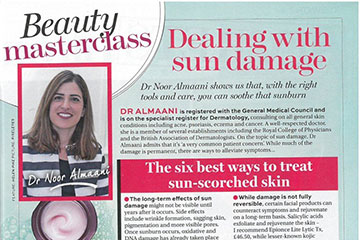
Dealing with sun damage
DERMATOLOGY
Best Magazine
DR ALMAANI is registered with the General Medical Council and is on the specialist register for Dermatology, consulting on all general skin conditions including acne, psoriasis, eczema and cancer. A Well-respected doctor, she is a member of several establishments including the Royal College of Physicians and the British Association of Dermatologists. On the topic of sun damage, Dr Almaani admits that ‘it’s a very common patient concern’. While much of the damage is permanent, there are ways to alleviate symptoms…
The six best ways to treat sun-scorched skin
The long-term effects of sun damage might not be visible until years after it occurs. Side effects include wrinkle formation, sagging skin, pigmentation and more visible pores. Once sunburn occurs, oxidative and DNA damage has already taken place so, realistically, you can only counteract this to a small extent.
After intensive sun exposure, the skin becomes red and swollen which results in dilation of the blood vessels and dehydration. It can also mean increased absorption of products, so normal facial products can become more irritating. Limit your beauty regime to alcohol- and fragrance-free formulas until the redness goes down, so you’re less prone to reaction.
Avoid direct sunlight for around four days. Apply a lotion with a cooling ingredient (like aloe vera or cucumber) at night to hydrate and soothe.
While damage is not fully reversible, certain facialproducts can counteract symptoms and rejuvenate on a long-term basis. Salicylic acids exfoliate and rejuvenate the skin – I recommend Epionce Lite Lytic Tx, £46.50, while lesser-known Kojic acid works on pigmentation – try Skinceuticals Phyto Corrective Gel, £49. Restrict application to a month after your holiday and at night-time only. Use after cleansing and before moisturising. Follow up with SPF in the morning.
Supplements taken orally can also help repair your complexion. Vitamins C and E help reduce damaged cells and preserve the active ones.
Prevention is better than cure so daily application of SPF is vital. To increase your protection, apply it 20 minutes before wearing clothes of going out. Re-apply after heavy sweating or swimming to get the maximum effect.




